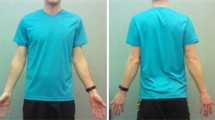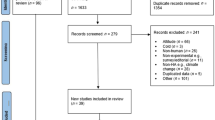Summary
Metabolic heat production (M), clothing heat transfer characteristics, and the environment dictate a required evaporative cooling (Ereq) from the body to maintain thermal balance. However, the maximal evaporative capacity (Emax) is dictated by vapor transfer properties of the clothing and environment. Relationships between metabolic load, environmental conditions, clothing and sweat loss were studied in 34 heat-acclimatized males categorized into four groups (eight, eight, eight, and ten subjects) and exposed to various environmental conditions (ambient temperature, 20–54‡ C, and relative humidity, 10–90%), three levels of metabolic rate (resting; walking 1.34 m·s−1, level; or walking 1.34 m·s−1, 5% grade) while wearing various clothing ensembles (shorts and T-shirts, fatigues, fatigues plus overgarment, or sweat suit). Individual groups were not exposed to all combinations. Exposures lasted 120 min: either 10 min rest — 50 min exercise — 10 min rest — 50 min exercise, or 120 min at rest. Physiological measurements included heart rate, rectal temperature, mean skin temperature, energy expenditure and sweat loss (δmsw). Emax and Ereq were calculated from environmental conditions, metabolism, clothing insulation and permeability. The ratio Ereq/δmsw was found to correlate with Emax and not with M. The predictive equation for sweat loss was: δmsw=18.7×Ereq×(Emax)−0.455 within the limits 50<Ereq<360; W·m−2 and 20<Emax<525; W·m−2. This formula predicts sweat loss for specific work loads, climates and clothing ensembles.
Similar content being viewed by others
References
Benzinger TH, Kitzinger C, Pratt AW (1963) The human thermostat. In: Hardy JD (ed) Temperature: its measurement and control in science and industry, vol 3, part 3. Reinhold, New York, pp 637–665
Bligh J (1978) Thermoregulation: what is regulated and how? In: Houdas Y, Guieu JD (eds) New trends in thermal physiology. Masson, New York, pp 124–126
Bullard RW, Banerjee MR, MacIntyre BA (1967) The role of the skin in negative feedback regulation of eccrine sweating. In J Biometeorol 11: 93–104
Burton AC (1935) Human calorimetry II. The average temperature of the tissue of the body. J Nutr 9: 261–280
Candas V, Libert JP, Vogt JJ (1979) Human skin wettedness and evaporative efficiency of sweating. J Appl Physiol 46: 522–528
Davies CTM (1979) Influence of skin temperature on sweating and aerobic performance during severe work. J Applied Physiol 47: 770–777
Gagge AP (1937) A new physiological variable associated with sensible and insensible perspiration. Am J Physiol 120: 277–287
Givoni B (1963) Estimation of the effect of climate on man: development of a new thermal index. Res Rep UNESCO Haifa: Israel Institute of Technology
Givoni B, Goldman RF (1972) Predicting rectal temperature response to work, environment, and clothing. J Appl Physiol 32: 812–822
Givoni B, Goldman RF (1973) Predicting heart rate response to work, environment, and clothing. J Appl Physiol 34: 201–204
Givoni B, Berner-Nir E (1967) Expected sweat rate as function of metabolism, environmental factors and clothing. Res Rep UNESCO Haifa: Israel Institute of Technology
Gonzalez RR, Berglund LG, Gagge AP (1978) Indices of thermoregulatory strain for moderate exercise in the heat. J Appl Physiol 44: 889–899
Houdas Y, Lecroart JL, Ledru C, Carette G, Guieu JD (1978) The thermo-regulatory mechanisms considered as a follow-up system. In: Houdas Y and Guieu JD (eds) New trends in thermal physiology. Masson, New York, pp 11–19
Kerslake DMcK (1963) Errors arising from the use of mean heat exchange coefficients in the calculation of the heat exchanges of a cylindrical body in a transverse wind. In: Hardy JD (ed) Temperature: Its measurement and control in science and industry, vol 3, part 3. Reinhold, New York, pp 183–189
Kerslake DMcK (1972) The stress of hot environments. Cambridge University Press, London, pp 145–156
Lustinec K (1973) Sweat rate, its prediction and interpretation. Arch Sci Physiol 27: A127-A136
Macpherson RK (ed) (1960) Physiological responses to hot environments. Medical Research Council Special Report Series No. 298, Her Majesty's Stationery Office, London, pp 219, 294–299
McCallrey TV, Wurster RD, Jacobs HK, Euler DE, Geis GS (1979) Role of skin temperature in the control of sweating. J Appl Physiol 47: 591–597
Mitchell D, Senay LC, Wyndham CH, Van Rensburg AJ, Rogers GG, Strydom NB (1976) Acclimatization in a hot, humid environment: Energy exchange, body temperature, and sweating. J Appl Physiol 40: 768–778
Nadel ER, Stolwijk JAJ (1973) Effect of skin wettedness on sweat gland response. J Appl Physiol 35: 689–694
Pandolf KB, Givoni B, Goldman RF (1977) Predicting energy expenditure with loads while standing or walking very slowly. J Appl Physiol 43: 577–581
Woodcock AH, Breckenridge JR (1965) A model description of thermal exchange for the nude man in hot environments. Ergonomics 8: 222–235
Author information
Authors and Affiliations
Rights and permissions
About this article
Cite this article
Shapiro, Y., Pandolf, K.B. & Goldman, R.F. Predicting sweat loss response to exercise, environment and clothing. Europ. J. Appl. Physiol. 48, 83–96 (1982). https://doi.org/10.1007/BF00421168
Accepted:
Issue Date:
DOI: https://doi.org/10.1007/BF00421168




